Today in Tedium: If you’re reading this right now and you’re in the U.S., you’re probably thinking about two things: One, can we talk about something other than technology for five minutes? And two, what time is Thanksgiving dinner? The answer to the first is this newsletter, and the answer to the second is very much sometime Thursday. Helping to speed the process for millions of homes is a mix that comes in a box that has simplified one of the most complicated parts of Thanksgiving dinner—the stuffing. Today’s Tedium talks about Stove Top, which celebrates its 50th anniversary this year, and other stuff about stuffing innovation. — Ernie @ Tedium
Editor’s note: This story has been updated from the original with additional context from former General Foods marketer Jack Klinge, who was involved in the development of Stove Top Stuffing.
Find your next favorite newsletter with The Sample
Each morning, The Sample sends you one article from a random blog or newsletter that matches up with your interests. When you get one you like, you can subscribe to the writer with one click. Sign up over this way.
Today’s Tedium is sponsored by The Sample. (See yourself here?)
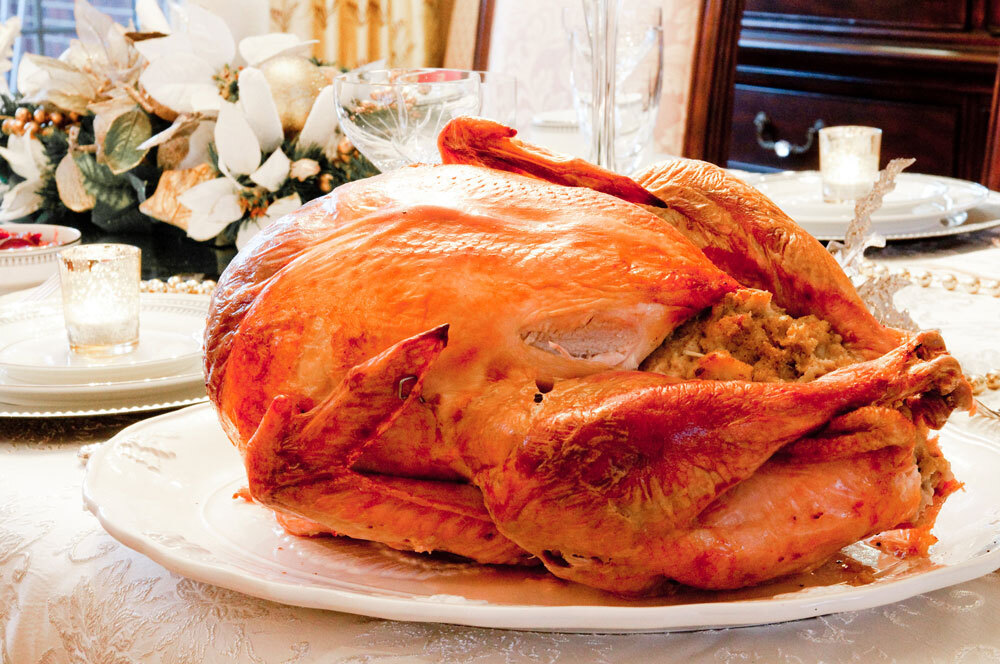
(Puparrazi PhotographY/Flickr)
Why do we stuff foods with other types of food, anyway?
Putting stuffing in food sure beats keeping the innards inside of that food in many cases. If it’s an animal like a bird, it often has parts you probably don’t actually want to eat. If it’s a plant or vegetable, it replaces a seed or a hollow body.
It has a long history that is closely associated with Ancient Rome in particular, with early chef Marcus Gavius Apicius a key stuffing enthusiast. His work Apicius, De Re Coquinaria features him talking about stuffing all sorts of animals, and was likely an inspiration for later stuffing enthusiasts like King Henry VIII (don’t ask). And this wasn’t purely a Western thing, with We just love stuffing things inside of animals for some reason, including other animals!
As weird as that all sounds, the history of stuffing may in fact have a throughline to the Pilgrims, but it’s not confirmed. As Smithsonian wrote: “It is possible that the birds were stuffed, though probably not with bread. (Bread, made from maize not wheat, was likely a part of the meal, but exactly how it was made is unknown.) The Pilgrims instead stuffed birds with chunks of onion and herbs.”
(As many modern ingredients of a Thanksgiving meal were not as prominent at that time, the possibility that the birds might have been stuffed is notable as it potentially offers a lineage to the modern day.)
Stuffing has gained a reputation as being a strongly regional food both in terms of its nomenclature—it is common for Southerners and Midwesterners to use “dressing”—and its ingredient list. For example, it’s common in areas near oceans to use seafood like oysters and clams in the stuffing mix.
Ultimately, though, when a product like stuffing is built for a more mainstream market, the final result is winnowed down into its most mainstream, least regional form.
And that form is instant stuffing.
“It’s that wild imagination I have and the physical abuse I give myself to make it happen. One of the greatest pleasures of my life has been to be able to do things like the Turducken that make people happy. It’s a huge effort but once you taste it, it is literally the best.”
— Chef Paul Prudhomme, speaking of the turducken, a turkey-meets-duck-meets-chicken concoction that Prudhomme is said to have invented in the late 1970s and trademarked in 1986. That’s right, years before John Madden discovered it, it was a Louisiana delicacy.
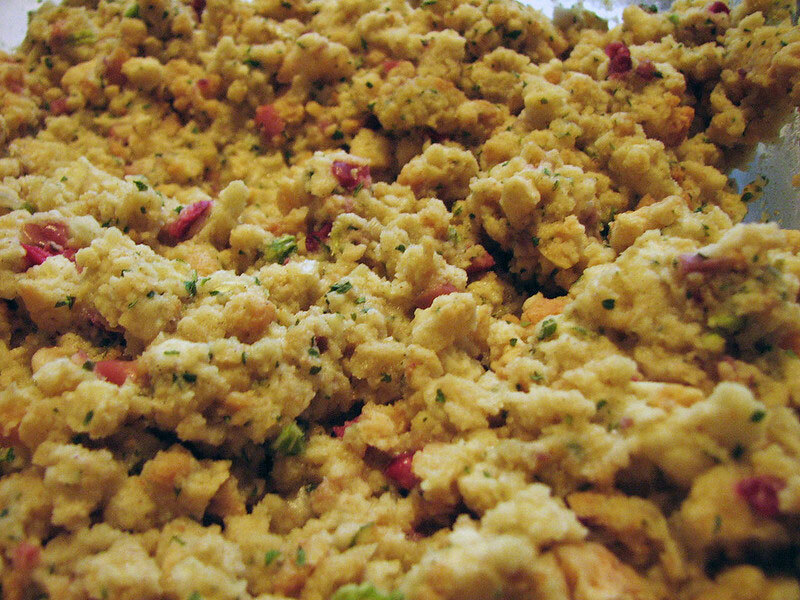
Stove Top was an innovator in instant stuffing, but it was not the first
In many ways, the magic thing about stuffing is that it is so absurdly simple to make, even though it seems like it should be harder. All you literally have to do is boil water and butter, heat it, add the mix, stir, wait, and you’re done. Given the complexity of making most other parts of a Thanksgiving dinner, cutting the amount of time needed to make one of the most popular elements has been one of the most important shortcuts available to amateur chefs of all stripes.
That simplicity has even made stuffing, once a food heavily associated with Thanksgiving, a dish that can be served at any time of the year, no big deal.
But the history of how instant stuffing mix evolved has been somewhat scattered.
Stove Top, while obviously the dominant player, was not the first stuffing mix on the market.
As far as I can tell based on an analysis of newspaper advertising and mentions in books and magazines, around four companies started selling it in different parts of the country around the same period.
Easily the best known of the four is Pepperidge Farm, the Connecticut-born company (owned today by the Campbell Soup Company) that first started selling the mix as early as 1947 as a “ready-to-use herb seasoned stuffing.”
Pepperidge Farm’s success was quickly replicated. One other then-prominent brand to land on the model early was Bond Bread, which made its own starting in 1951.
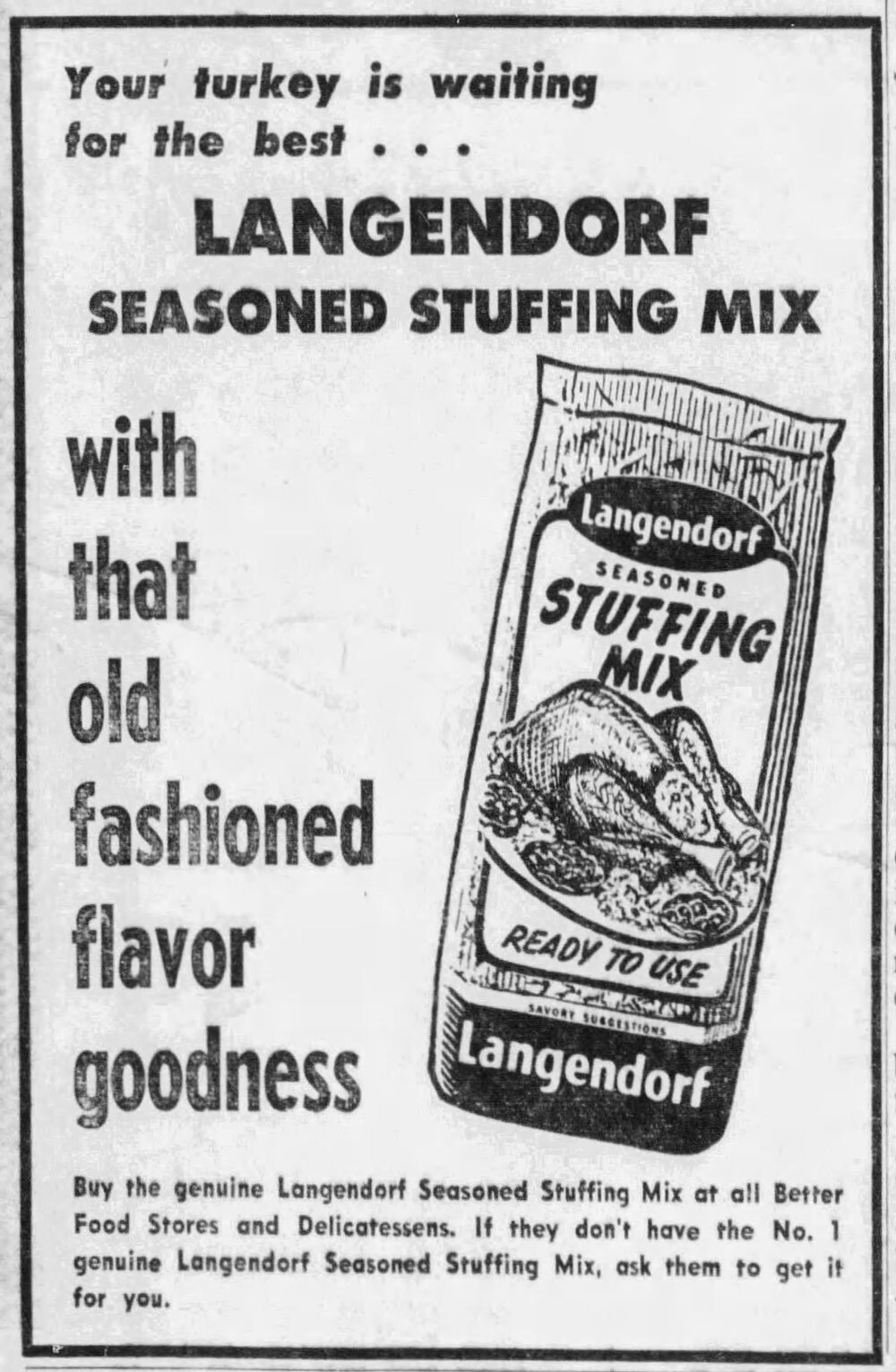
Meanwhile, California-based Langendorf Bakeries, founded in the 1890s, first selling instant stuffing mixes in the 1950s. A Los Angeles Daily News article from 1951 described the mix as such:
Langendorf recently brought out I a new seasoned stuffing mix, made of high quality Langendorf bread that is cubed to just the right size, delicately seasoned with sage, salt and pepper, and combined with celery, onion and egg yolk. One package of this seasoned stuffing mix is just right for a small turkey say, a bird of 8-lb. size; add water, according to package directions, and your dressing is all made.
While Langendorf, once a highly popular West Coast maker of bread, faded from view after its acquisition by American Bakeries in 1964, the mix was still sold for decades after that acquisition, with ads running for it as late as 1987.
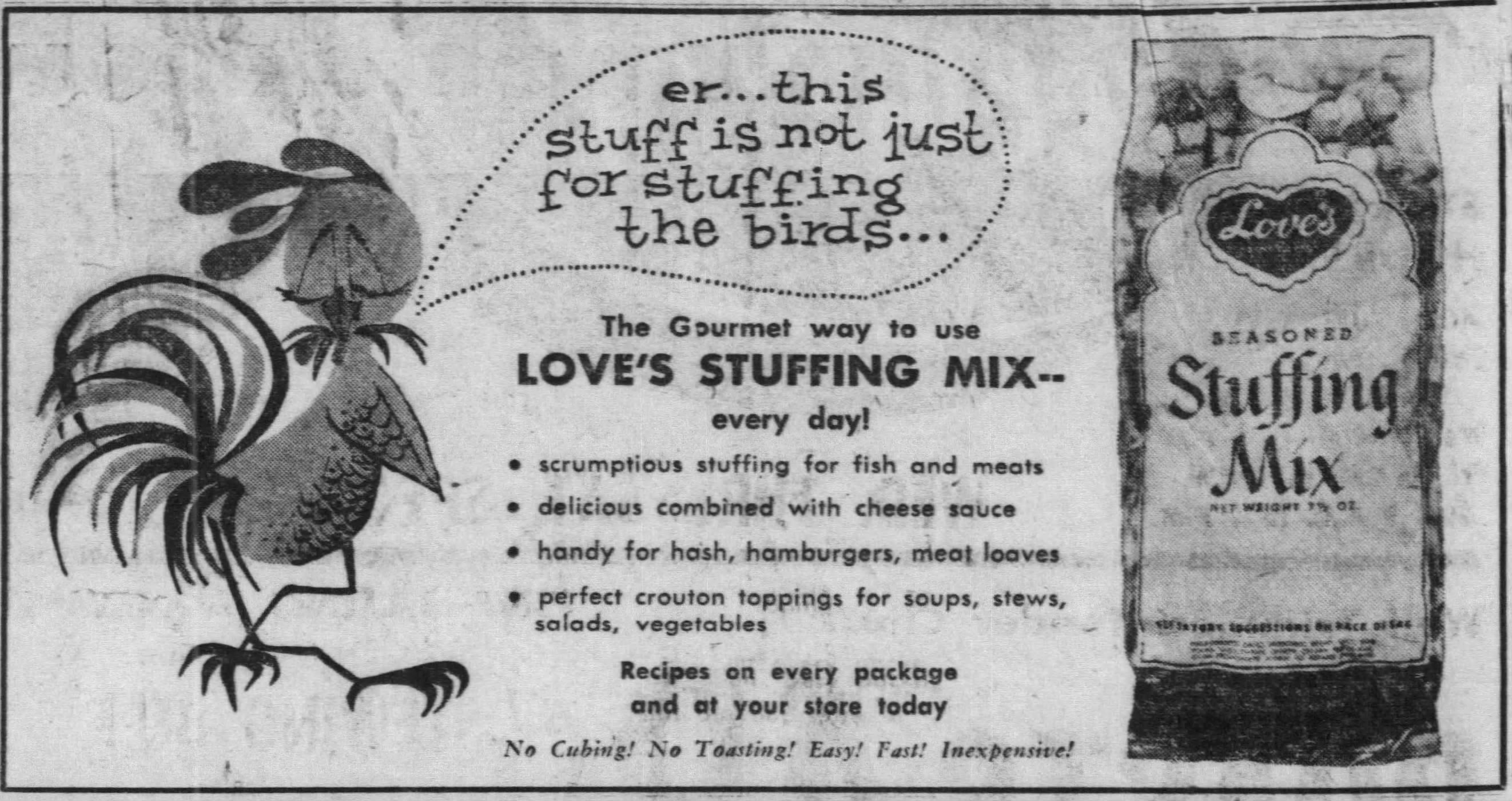
An ad for Love’s Stuffing Mix. Note that it’s recommended as a stuffing for fish as well as poultry. (Honolulu Star-Bulletin/Newspapers.com)
Finally, a still-active regional manufacturer of instant stuffing mixes that started selling during the 1950s is the Hawaii-based Love’s Bakery, which maintains a regional pull to this day along with Love’s other bread products. One of the early mentions I can find of that product is from 1954. (Perhaps it’s a source of regional popularity of stuffing; the major grocery chain Aldi sells a stuffing mix made with Hawaiian sweet bread.)
One distinctive difference between these variants of stuffing and Stove Top is that, at least in the 1950s, they required the addition of shortening rather than the butter that Stove Top uses. (Although butter is technically a form of shortening.)
These mixes were first, but they offered room for improvement, which is why Stove Top ultimately came to dominate. (Though there are still plenty of fans of the Pepperidge Farm mix.)
“I thought Stove Top was pretty darn good. I was prepared not to like it for some reason, but when I tried it I changed my mind. It is good.”
— An amateur reviewer of Stove Top stuffing in a 1974 article published in the Dayton Daily News, at a time when the instant stuffing mix was still relatively new and novel. Other sample comments from reviewers in the article: “Everyone thought it was a nice change from potatoes,” “I just don’t care for anything real spicy and Stove Top is a little too much so for me,” and “I’d really rather have homemade, but the Stove Top was pretty good.” Everyone has an opinion on Stove Top, clearly.
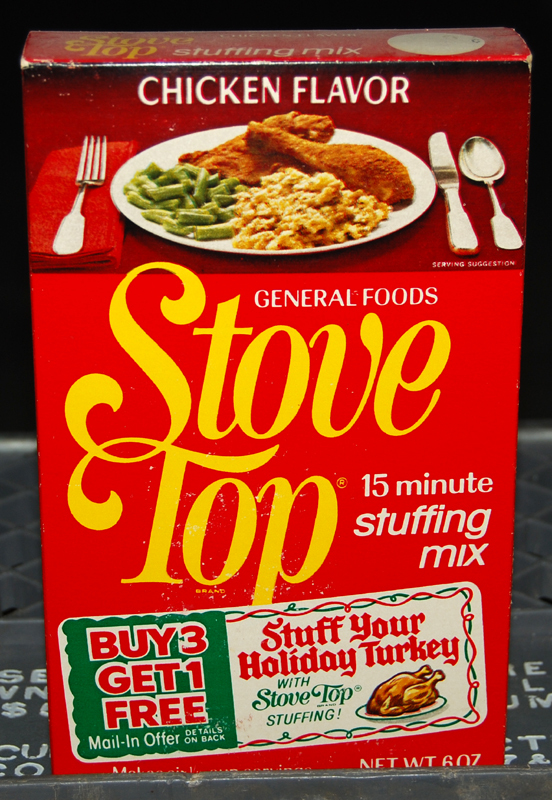
General Foods’ Stove Top: The stuffing concept that won out
In many ways, the development of Stove Top is somewhat reminiscent of instant mashed potatoes, another key form of quick-production Thanksgiving food that was greatly improved with a focus on food science.
It did have some differences, though, in that much of the innovation took place inside the doors of a single company, rather than an outside research lab.
The concept was uncovered the General Foods marketing team. Jack Klinge, a member of that team who is now a legendary local politician in Connecticut, said that his team came across the opportunity after testing different flavors of General Foods’ existing dinnertime hit, Minute Rice. The marketers realized that the stuffing flavor stood out as having potential, then decided to extend the idea to an easy-cook stuffing, using dried breadcrumbs instead of rice.
“We brought together different teams to test the right recipe,” he said in a brief interview.
(It wasn’t Klinge’s only hit as a marketer, by the way. He was also closely involved in the promotion of Arm & Hammer baking soda as having use cases beyond cooking, and also spent time in the trading card industry as a marketer—a fact I was able to confirm via newspaper archives. “I have a lot of things I can look back on,” he added.)
So, which team won? Simply put, plenty of food technologists were involved, but it was a home economist, a woman named Ruth Siems, who was able to take a lead role in research and development of the product, outpacing the technologists. In a 1991 interview with the Evansville Courier and Press, she noted that usually home economists were asked to come in after the food technologists developed a product to test it.
“That’s backwards,” she told the newspaper. “Home economists belong in development.”
Siems’ tactic for developing the best stuffing recipe came down not to weird chemicals or an unusual cooking method, but by utilizing the right bread crumbs at the right size, as cited in the patent she was awarded with co-developers Anthony C. Capossela Jr., John F. Halligan, and C. Robert Wyss:
After baking, the bread is staled or dried to a moisture content of below about 15 percent, preferably below about 5 percent. The drying is best effectuated by exposing the bread to moderate temperatures and circulating air. Bread crumbs of the appropriate particle size distribution are prepared by grinding. the dried bread and screening to the desired particle size.
The particle size distribution of the dried crumb used in this invention is also a significant factor in the preparation of a stuffing mix which will readily hydrate to the proper texture and mouthfeel. Crumb having a particle size larger than 2 U.S. mesh [one-half inch screen size] does not uniformly hydrate a short period of time with the result that dry, semi-dry and moist areas may be found within the same sample. Crumb having a particle size smaller than 50 U.S. mesh tends to over hydrate and become slimy or pasty. For the purposes of this invention it has been found that the particle size distribution of the crumb should be such that at least about 95 percent by weight of the crumb passes through a 2 mesh screen and no greater than about 5% by weight passes through a 50 mesh screen. It is within this range of particle size distribution that the proper balance of texture, moistness and mouthfeel is obtained. Preferably, at least 50 percent by weight of the crumb component ranges from 3 to 14 mesh in size.
This patent gave Siems a cultural role strong enough that she was the subject of a New York Times obit when she died in 2005. (The “mouthfeel” line, a word commonly used in patent filings, was cited in the article.)
For General Foods, which merged with Kraft in 1990, it gave them something they could sell as an alternative to mashed potatoes for the average dinner—as highlighted in the commercial above, in which the phrase “Stove Top instead of potatoes” is used. While they were not the first to instant stuffing, as cited above, the extra work put into the right recipe had a significant effect on the final result.
It was very clearly a hit. But being a mainstream consumer foodstuff, it would adapt to reach even more markets over time. And that’s where marketing took the reins.
1850
The year that Catherine Esther Beecher published Miss Beecher’s Domestic Receipt Book: Designed As A Supplement To Her Treatise On Domestic Economy, a pivotal book in the history of stuffing, as it highlighted the word “dressing” as a term interchangeable with “stuffing.” This distinction, caught by the food blog Martha & Tom in 2009, helped push back against a prevailing theory of the period, that stuffing was only used if it went in the bird, and dressing was used if it didn’t.
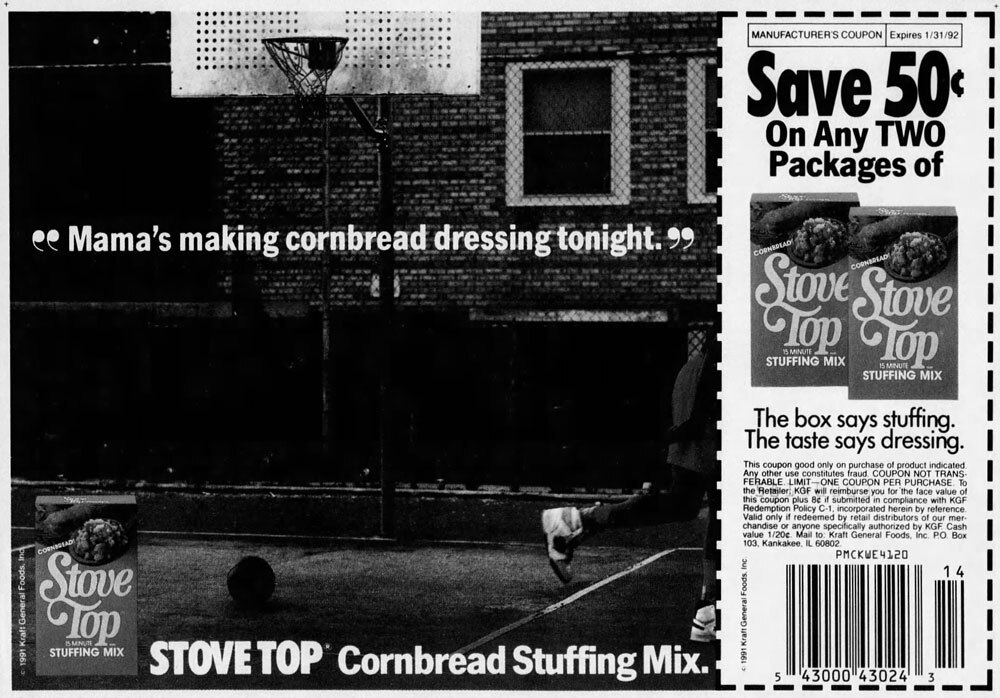
A 1991 ad for Stove Top targeted at Black audiences; it was the work of a Black-owned ad agency whose co-founder was one of the first people of color to work in the advertising industry. (Clarion-Ledger/Newspapers.com)
How Stove Top adapted its marketing approach for Black customers—with the help of a legendary adman
By the early ’90s, Stove Top had found its place as one of America’s dominant side dishes, but it was facing limitations to its growth because it had become a firmly established product.
Part of this comes down stuffing’s differing cultural roles throughout the United States, as reflected in the varied uses of the term “stuffing” and “dressing.” Cornbread stuffing in particular has a strong cultural association with Black culture, as best put by a 2015 Vice piece that described the roots of pre-Civil-War roots of kush, the dish that became cornbread stuffing:
Much like “stuffing” vs. “dressing,” its heritage and story have been largely forgotten, suggesting a quaint legacy of “making do” while ignoring the burdens of a very real and tragic history. You guessed it: If it’s Southern and it predates Civil War, it means we’re talking about slavery. The fact is that enslaved people’s hands crafted the most popular American stuffing out of old cornbread.
(The author, Michael Twitty, went on to note that the food’s roots in slavery highlight how the dish in eventually came to transcend those roots. “For me, it’s also the story of how one dish can show connections between groups of people believed to be irreconcilably divided,” he said.)
In many ways, Stove Top’s cornbread stuffing was a very distant (and commercialized) descendant of this original form of dressing, but one that perhaps was not well-positioned in the market.
It was in this position that Burrell Communications was asked to help find one. An ad agency co-founded by Tom Burrell, a legendary adman who was once described as “the first Black person in Chicago advertising,” his firm, built after a decade of working in ad agencies throughout the city, uncovered success by helping major companies reach Black consumers, particularly major food brands. He was one of the first advertisers that focused on targeting specific demographics rather than aiming for the mass market—something that basically every advertiser not running their ads on the big three broadcast networks now does.
As highlighted in the 1995 book Advertising and Marketing to the New Majority, Burrell’s team built a series of hypotheses around the target audience of this product, including the fact that Black consumers favored using the term “dressing”; had a preference for cornbread stuffing; considered stuffing a homemade, traditional product; and tended to have stuffing and potatoes during holiday meals, meaning that the “Stove Top instead of potatoes” line would be ineffective.
The firm did market testing to confirm these hypotheses and found that box stuffing was unpopular with Black consumers because they felt it was “cheating” to not use a homemade recipe, and that the Black women surveyed were concerned their kids may not eat it.
But there were still openings—with younger consumers open to the product, and older consumers willing to use it as the base of a larger recipe. Burrell Communications got to work, and ended up building a campaign that spoke to the traditionalism and the convenience in equal counts.
The tagline for the print ads? “The box says stuffing. The taste says dressing.” Simple and brilliant.
The campaign also got a boost from television ads that underlined the same point, highlighting kids in an urban environment who were quick to head home after learning cornbread dressing was on the menu. This hit the pain point cited by market research that kids wouldn’t eat box stuffing.
The result of this campaign? Sales went through the roof, with awareness of Stove Top within the target market significantly increased. It was such an exemplary example of correctly targeting a market that it was written about in books.
Today, Stove Top is just one of a pantheon of mainstream brands that tries to do anything it can to maintain a role of relevance in our lives.
An example of this was a product it has periodically sold in recent years called “stuffing pants,” essentially a pair of sweatpants with Stove Top branding and a stretchable waistband illustrated with the product. (There is also a pocket for leftovers, in case there is any stuffing leftover.)

I find it so weird that this is how Stove Top markets itself in 2022. (BusinessWire)
Essentially they are stunt pants, which fit well with the Thanksgiving collection the brand sold a couple of years ago.
This feels like an approach not dissimilar to how ranch dressing markets itself these days. Or McDonald’s. The goal appears to be to go viral, and my link likely assists with their goal.
Anyway, if anyone can tell me exactly what the heck Stove Top is doing these days, please let me know, because this seems like a pretty weird way to celebrate Ruth Siems’ legacy.
--
Find this one an interesting read? Share it with a pal!
Are you a Mastodon user? Be sure to give Ernie a follow!
And thanks to The Sample for giving us a push this time. Be sure to subscribe to get an AI-driven newsletter in your inbox.





